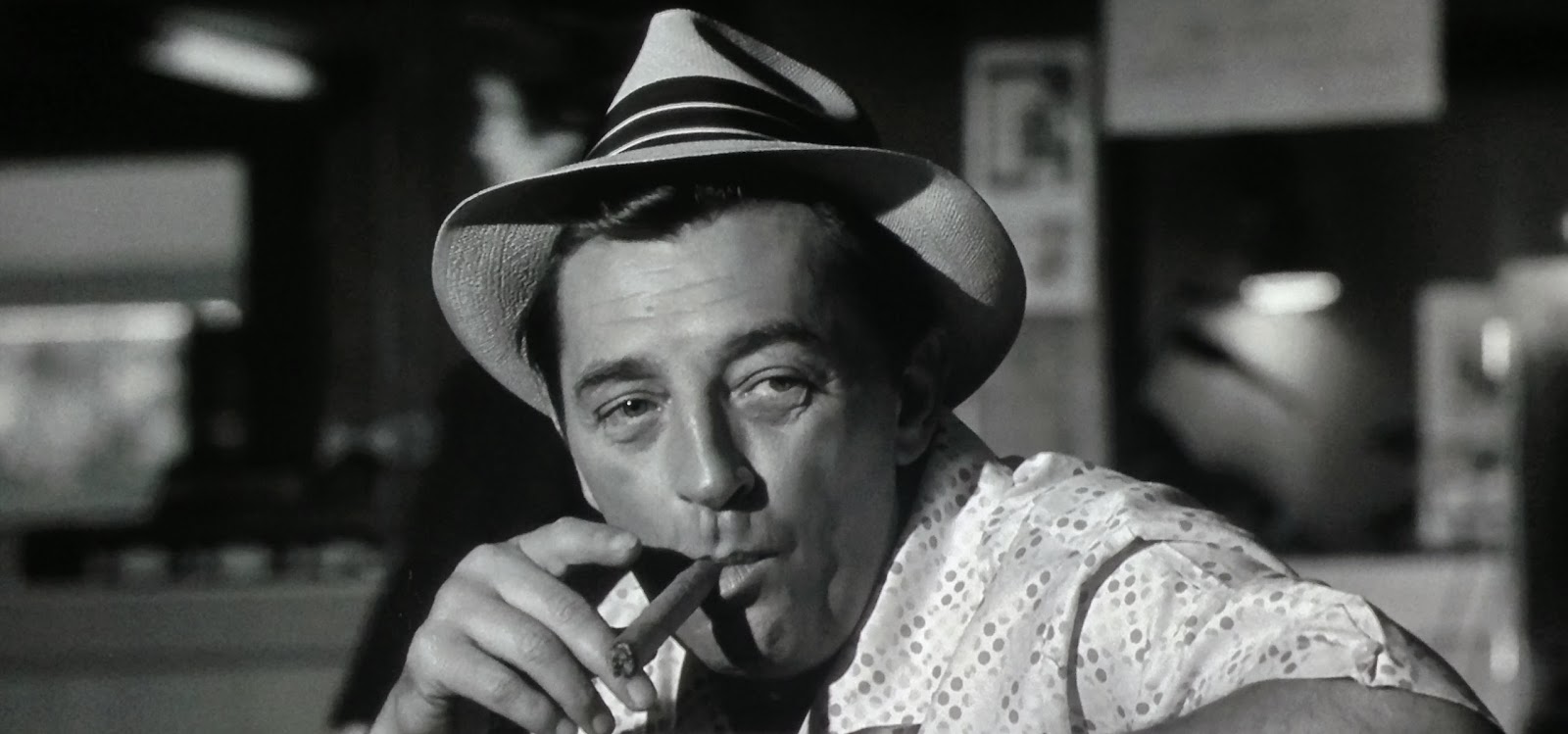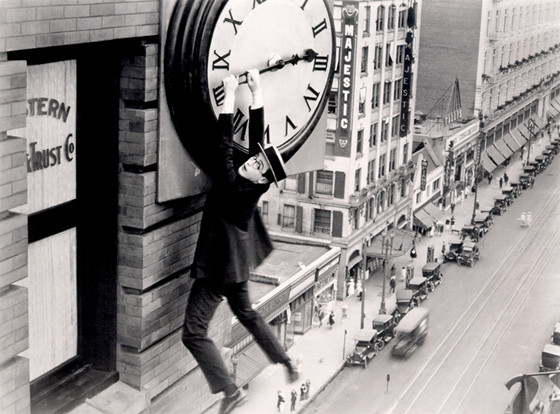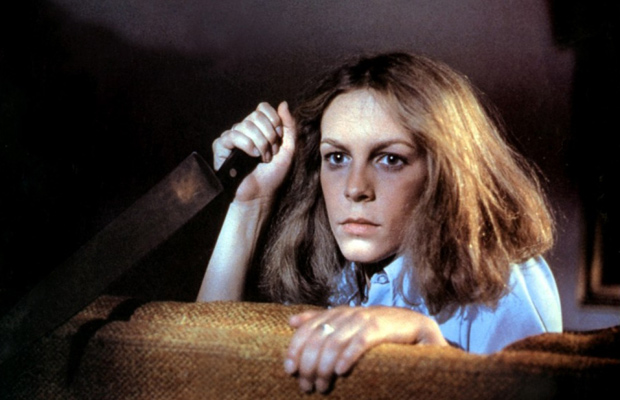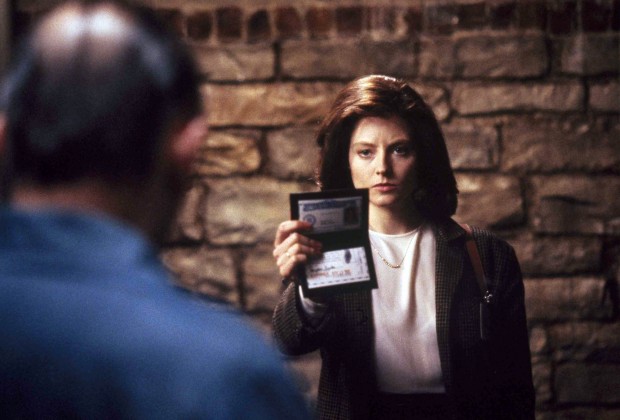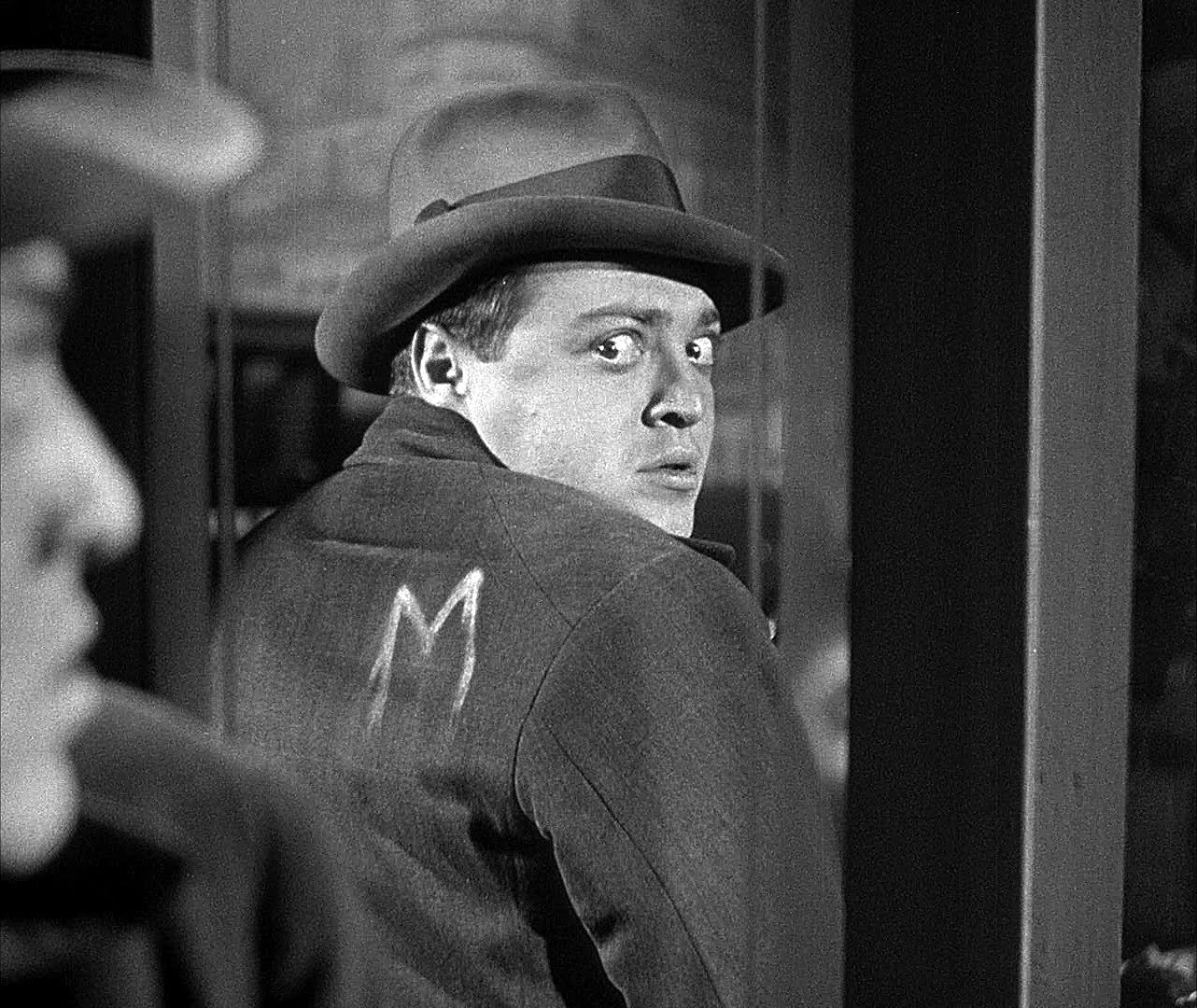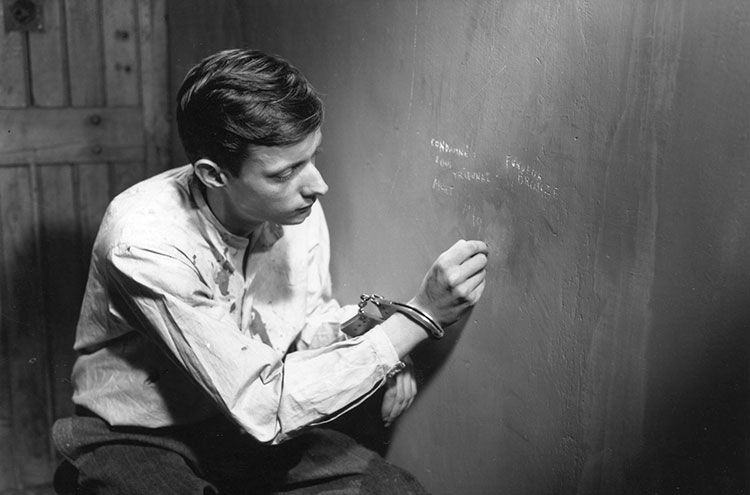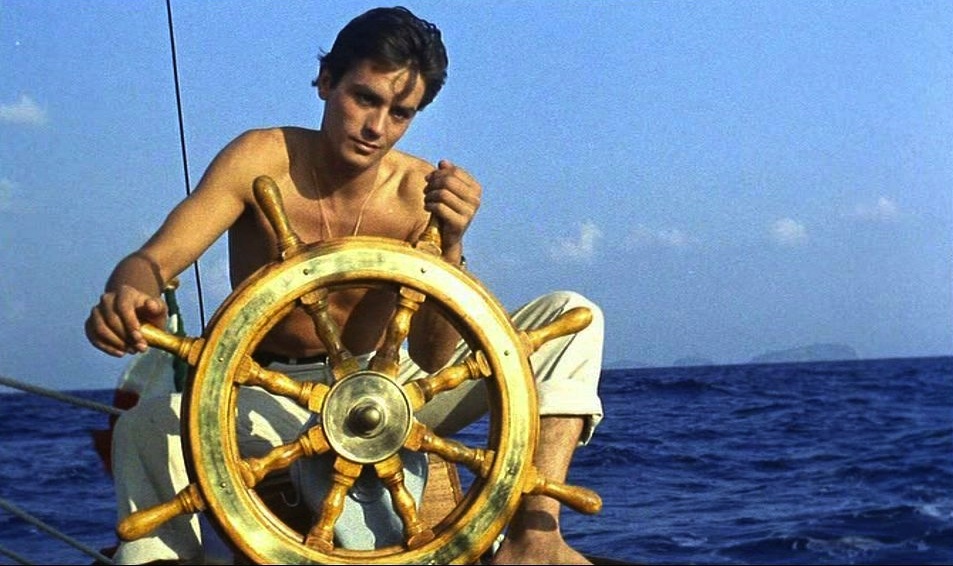15. Cape Fear (dir. J. Lee Thompson, 1962)
B-movie purveyor J. Lee Thompson made his best film with this 1962 classic thriller. Robert Mitchum plays Max Cady, the serial rapist Gregory Peck’s lawyer Sam Bowden puts away only to be set free years later to terrorize him and his family. The film’s merits admittedly rest heavily upon Mitchum’s truly disturbing, insidious performance as Cady, as well as the excellent score by Bernard Herrmann (which Scorsese used note for note in his 1991 remake.)
The simmering threat beneath Mitchum’s laconic Southern moves and baritone voice gathers like a humid, Florida storm until it strikes with terrifying force. While Martin Scorsese’s 1991 remake featuring Robert DeNiro’s gonzo performance as Cady makes some interesting changes to the character as well as to the Bowden family, it often veers unevenly in tone and pacing with long scenes of over-the-top marital strife bumping up against an almost supernatural adversary in DeNiro’s version of Max Cady.
Both films are truly worth seeing, but the original feels organically like a Suspense-Thriller, while Scorsese’s plays more as Arthouse-Horror.
14. Safety Last (dir. Fred C. Newmeyer and Sam Taylor, 1923)
Comic relief is an excellent and oft-neglected device Hitchcock and many of the great suspense writers would employ to decompress the suspense from their audience in order to reset them so that they could ratchet the tension back up to an even higher pitch creating the dynamic ups and downs of an emotional roller coaster ride.
But can an out and out comedy also be considered a suspense-thriller? If so, then Harold Lloyd’s “Safety Last” would be example numero uno. The film is a classic Comedy with a capital “C” to be sure – but one that will still have the viewer gripping their seat with one hand, while gnawing their fingernails off the other as much as any film on this list.
Harold Lloyd performs his own stunts, no wires, obviously no CGI, climbing the façade of a New York Department Store all for the store’s publicity stunt to earn enough extra money to bring his sweetheart to the big city. To this day, Lloyd’s feat of physical comedy while genuinely risking his life continues to be a jaw-dropping, heart palpitating, laugh out loud experience that needs to be seen on the big screen to be believed.
13. Halloween (dir. John Carpenter, 1978)
Before the countless sequels that made him into an indestructible killer, before the boring explanations about who he is and why he kills, before the ridiculous remakes where Michael Myers was relegated to being a picked on child from a broken home, it is worth noting that the original, “John Carpenter’s Halloween” is a terrifying, minimalist Suspense-Thriller.
Inspired by Alfred Hitchcock’s “Psycho,” “John Carpenter’s Halloween” is a story of a boy who goes inexplicably insane one night and kills his sexually permissive sister. Twenty years later, on the anniversary of her death on Halloween, he escapes from the Mental Institution and returns to his hometown to reenact his obsession with those who remind him of his murdered sister.
Meanwhile, we meet the shy, bookish, virginal Laurie Strode and her two promiscuous high school friends as they prepare for their night of babysitting and partying. We get to know Laurie and her friends, and we like them. We especially like and care for Laurie, and the two children she babysits for. Arriving in town is Dr. Sam Loomis who has come back to his patient’s hometown on a hunch he’d return here.
He tells the Sheriff his experience with his patient Michael Myers, and we’re fascinated and chilled to the bone by his tales. These two men couldn’t be more different, yet they have a mutual respect for one another and we grow to like them as well.
“Halloween” is a Suspense-Thriller in the grand tradition, with well-developed characters we care about in a terrifying situation grounded in reality that keeps getting worse, as we hope against hope that these characters we have gotten to know and have empathy for will survive the night.
Like Hitchcock’s “Psycho”, the gore is never on screen, always implied. And what of the supernatural killer that can’t be killed? Well let’s examine this: He is stabbed by a knitting needle and a wire coat hanger by a teenaged girl (not exactly lethal blows) before being shot by a doctor who’s never handled a firearm (50 Cent’s survived worse) after which he falls from a two-story window (I’ve survived worse.)
Highly unlikely he would survive all of this, but not beyond the realm of reality. It is for these reasons that “John Carpenter’s Halloween” should no longer be regarded as a “Slasher” film, or even as a “Horror” film, but should truly be regarded as a Hitchcock-worthy Suspense-Thriller.
12. The Silence of the Lambs (dir. Jonathan Demme, 1991)
One of only three films to sweep the top five Oscars of Best Picture, Actor, Actress, Director and Best Adapted Screenplay (the other two being “It Happened One Night” and “One Flew Over the Cuckoo’s Nest”), “The Silence of the Lambs” is the only Horror film to be so widely praised throughout the entire film community. But is it a Horror Film?
With a level of gore more inferred than applied and with its richly developed characters, relationships and feminist themes clearly being Demme’s focus, I would argue that “Silence” straddles the line like no other film before it or since: a Horror film that chose to function more within the parameters of the Suspense-Thriller and a Suspense-Thriller that heads to the border of Horror until you’re assured it won’t cross over, until over it goes, but sparingly. Demme’s knowledge of this razor’s edge multiplies the overall dread of this film, and in my mind, confirms its status as one of the greatest Suspense-Thrillers of all time.
Watch Demme’s oddly cool camera movements perfectly capture the seemingly serene surface of all the men leering upon Jodie Foster’s lone woman in a man’s world. Foster gives one of her best performances as F.B.I. Agent Clarice Starling, a rookie who must rise to the challenges all around her, including those she faces from her cryptic, compliment prone boss played by the eerily placid Scott Glenn.
In fact, Starling has only one male ally in the film who is exactly who he purports himself to be; unfortunately he purports himself to be absolutely psychotic. What can be said about Sir Anthony Hopkins’ performance as Hannibal ‘The Cannibal’ Lecter that hasn’t already been said? Let’s just say the world may never be able to order a nice Chianti ever again without thinking of his slithering madness.
11. Persona (dir. Ingmar Bergman, 1966)
Is Ingmar Bergman’s seminal work a piece of cinematic art? Most definitely. Is it also a searing psychological-drama? Yes. Is it as film scholar Lloyd Michael’s once wrote a “modernist-horror” tale? Okay, maybe that, too. But does it also fray the nerves and slow burn your sense of worry and anxiety for a character as only the best straight ahead Suspense-Thrillers can do?
Absolutely. Bibi Anderson plays Nurse Alma, caring for Liv Ullman’s actress Elisabet Vogler who has mysteriously gone mute. But after her psychiatrist assigns Alma to care for Vogler at her private seaside home in Sweden, the caregiver becomes increasingly unhinged by Vogler’s silence, speaking to her mute patient of her life, her past shames, eventually prying into Vogler’s private mail where she discovers the actress has written condescendingly of the her, and that she is in fact “studying” her.
And this is where the unraveling of Alma’s mind (as well as the actual film stock, which may be one and the same) begins. There is nothing quite like “Persona” (I haven’t even mentioned the absolutely bat-shit crazy Prelude, presumably from inside the mind of Alma or Vogler or both). The film serves as the pinnacle of Bergman’s deeply personal cinematic work and has served as an influence to countless filmmakers, most notably Barbet Schroeder’s excellent “Single White Female” as well as David Lynch’s thrilling head-trip “Mulholland Drive.”
Shocking, disturbing and uncompromisingly artistic, it’s hard to know what today’s young filmgoer would make of seeing “Persona” for the first time. Perhaps it would be no different than audiences at the time of its initial release: aghast, appalled, and thrilled at the newly discovered possibilities of cinema.
10. M (dir. Fritz Lang, 1933)
Another film often debated upon as to its genre is Fritz Lang’s 1933 classic, “M.” Is this film about a serial child murderer stalking the streets of Berlin a Horror tale, a Noir, or with Lang’s focus on how the city’s different social strata react to the murders, is it a Social-Political Drama?
“M” is the combination of all of these genres and much as “The Silence of the Lambs” multiplied its suspense upon the film’s narrative riding the razor’s edge between Thriller and Horror, Lang’s dances on the edge of Horror, Crime-Thriller and Social-Political Drama with such finesses as to make it one of the most influential Suspense-Thrillers of all-time.
In Fritz Lang’s first sound film, Peter Lorre plays the titular child murderer who writes letters to the local paper begging the Police to find him and stop him. When the Police are pressured by the Upper Class to aggressively investigate all the local criminals as well as the homeless, the Criminal Bosses take it upon themselves to find, capture and convict the child murderer in their own court of law so that they can continue their own repulsive behavior… by choice.
One can find Lang’s “M” as an influence upon most urban tapestry thrillers such as Spike Lee’s “Summer of Sam” and David Fincher’s terrifying “Zodiac” as well as in the Superhero-Crime-Thriller “The Dark Knight Rises” with Bane’s Kangaroo Court led by homicidal maniacs convicting Gotham’s elite. “M” is a classic for a reason, holding up just as well today as a supreme force of drama and riveting suspense.
9. A Man Escaped (dir. Robert Bresson, 1956)
The prison break film is usually categorized as a sub-genre of the Action-Adventure film. However, Robert Bresson’s classic tale digs deeper as he tells the true-life suspense tale of a French Resistance fighter’s meticulous attempt to escape a Nazi Prison Camp within the French city of Lyon.
Bresson’s strips away as much artifice as he possibly could leaving us the blank concrete slab of life one is subjected to in a prison cell, where one’s obsessional focus fixates only upon escape, and one’s attention becomes almost microscopic as to the details involved in doing so.
Bresson uses sound never merely to double that which we see within the prisoner’s existence, but to inform and create the world outside his walls – the tapping code of a fellow prisoner, the squeaking of a Nazi guard’s bicycle as he patrols around the walls, the streets of Lyon that beckon his freedom only hundreds of feet away.
Bresson gives a master class in the use of sound as an instrument for the Suspense-Thriller, teaching us that sometimes that which can be heard and not seen can be the most threatening antagonist of all.
8. Purple Noon (dir. René Clément, 1960)
Fans of Anthony Minghella’s 1999 Matt Damon film “The Talented Mr. Ripley” owe it to themselves to see the French film “Purple Noon,” the first adaptation of Patricia’s Highsmith’s fantastic novel – an origin story for one of literature’s most oddly sympathetic sociopaths, Tom Ripley.
Director René Clément delivers the perfect combination of sun-splashed Technicolor madness as we truly get inside the mind of Alain Delon’s star making performance as Tom Ripley, the chameleon who yearns to either love or become the wealthy Philippe Greenleaf.
Though Clément’s conclusion takes too many liberties with Highsmith’s original ending, his ability to sustain a slow, creeping tension throughout as we, despite ourselves, worry as to how Tom will wriggle his way out of his crimes, is a true marvel to behold. It’s interesting to note that Ms. Highsmith was also the author of the book “Strangers on a Train,” another tale of repressed homoerotic longing turned violent which became the basis for one of Hitchcock’s greatest films.
